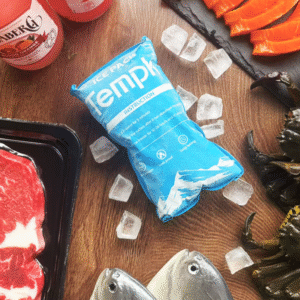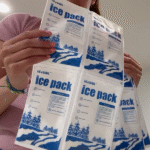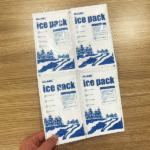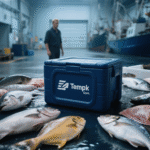Expédition de produits périssables tels que de la viande congelée, fruit de mer, et les glaces nécessitent une planification minutieuse pour garantir qu'elles maintiennent leur sécurité et leur qualité pendant le transport.. Un emballage approprié et la bonne quantité de neige carbonique sont essentiels pour conserver ces produits congelés.. Dans cet article, nous vous expliquerons comment calculer la bonne quantité de neige carbonique, fournir des lignes directrices pour des produits spécifiques, et offrir des conseils sur les meilleures pratiques d'emballage.
-
Comprendre le directives générales pour le calcul glace carbonique nécessaire pour les produits surgelés
-
Appliquer ratios spécifiques au produit pour la viande congelée, fruit de mer, et glace
-
Apprendre meilleures pratiques pour l'emballage de glace carbonique pour éviter la décongélation et la détérioration
-
Explorer le 2025 tendances du transport sous chaîne du froid comme des capteurs intelligents et des matériaux durables
-
Comprendre le exigences réglementaires et de sécurité lors de l'expédition de glace carbonique
Comment la glace carbonique maintient-elle les produits congelés pendant l'expédition?
La glace carbonique est un élément essentiel pour l'expédition de marchandises périssables. Contrairement à la glace ordinaire, qui fond dans l'eau, la neige carbonique se sublime directement en dioxyde de carbone à une température de -109,3°F (-78.5°C). Ce froid extrême permet de conserver la viande congelée, fruit de mer, et de la crème glacée à la température requise tout au long du processus d'expédition.
La propriété unique de la glace carbonique, la sublimation, garantit qu'elle peut maintenir un environnement de refroidissement sec et constant., mais cela signifie aussi qu'il disparaît progressivement au fur et à mesure qu'il se transforme en gaz. Comprendre ce processus est essentiel pour estimer la quantité de neige carbonique nécessaire pour différentes durées d'expédition et conditions environnementales..
Conseil: La glace carbonique est efficace pour des délais d'expédition plus longs, mais vous en aurez besoin de plus si vous expédiez dans des climats chauds ou pendant un transit prolongé.
Quels facteurs affectent la quantité de glace carbonique nécessaire?
La quantité de neige carbonique requise peut varier en fonction de plusieurs facteurs clés:
-
Durée d'expédition: Plus le délai d'expédition est long, plus vous aurez besoin de glace carbonique. Typiquement, la glace carbonique se sublime à un rythme de 5-10 des livres chacun 24 heures dans des conditions moyennes.
-
Température ambiante: La glace carbonique se sublime plus rapidement dans les climats chauds. Donc, il est important d'ajuster votre quantité de glace carbonique pour des températures plus élevées.
-
Taille du colis et isolation: Les emballages plus grands ou mal isolés nécessiteront davantage de neige carbonique pour maintenir la température souhaitée..
-
Type de produit: Différents produits nécessitent différentes quantités de neige carbonique pour rester congelés. Par exemple, la crème glacée nécessite des températures plus basses que la viande ou les fruits de mer, nécessitant ainsi plus de neige carbonique.
| Facteur | Impact sur les besoins en glace carbonique |
|---|---|
| Durée d'expédition | Les expéditions plus longues nécessitent plus de glace carbonique |
| Température ambiante | Le temps chaud accélère la sublimation, nécessitant plus de glace carbonique |
| Taille de l'emballage | Les emballages plus gros nécessitent plus de glace carbonique |
| Type de produit | La crème glacée a besoin de plus de glace carbonique en raison d'exigences de température plus strictes |
Meilleures pratiques pour l’expédition de produits surgelés
-
Utilisez des emballages isolés: Optez pour des contenants isolés comme du polystyrène ou des couvertures thermiques pour ralentir la sublimation de la neige carbonique et maintenir des températures froides plus longtemps..
-
Couche appropriée d'emballage: Placez la neige carbonique en bas et en haut de la boîte, avec le produit au milieu. Cela garantit un refroidissement uniforme.
-
Conteneurs ventilés: Évitez de fermer hermétiquement le récipient, car la neige carbonique doit se sublimer en gaz. Laisser de petits trous de ventilation permettra au gaz de s'échapper en toute sécurité.
De quelle quantité de glace carbonique ai-je besoin pour différents produits?
La quantité de neige carbonique dépend du type de produit et de la durée d'expédition. Voici une ligne directrice générale:
Pour la viande congelée:
-
Viande congelée: Pour chaque 5 lbs de viande congelée, utiliser environ 2.5 à 3 livres de glace carbonique pour une expédition en 24 heures.
-
Par exemple, un 10 lb expédition de viande nécessite 5-6 livres de neige carbonique pour une livraison en 24 heures.
-
Pour des délais de livraison plus longs, ajouter 1-2 livres de glace carbonique pour chaque 10 livres de viande par supplément 24 heures.
-
Pour les fruits de mer:
-
Fruit de mer: Les fruits de mer sont très périssables et nécessitent environ 3 lbs de glace sèche par 5 livres de fruits de mer pour une période d'expédition de 24 heures.
-
Par exemple, un 10 lb expédition de fruits de mer besoins environ 6 livres de glace carbonique pour 24 heures.
-
Pour un transit de 48 heures, utiliser 8 livres de glace carbonique pour le même 10 expédition de livres.
-
Pour la glace:
-
Glace: La crème glacée doit rester à une température de -20°F (-28.8°C). Vous aurez besoin 3 à 4 lbs de glace sèche par 5 livres de crème glacée pour une expédition en 24 heures.
-
Par exemple, un 10 lb expédition de crème glacée nécessite 6-8 livres de glace carbonique pour 24 heures.
-
Pour les expéditions de 48 heures, augmenter la glace carbonique à 8-10 lbs.
-
| Type de produit | Glace carbonique nécessaire (par 5 lbs) | 24-heure d'expédition | 48-heure d'expédition |
|---|---|---|---|
| Viande congelée | 2.5-3 lbs | 5-6 lbs | 7-9 lbs |
| Fruit de mer | 3 lbs | 6 lbs | 8 lbs |
| Glace | 3-4 lbs | 6-8 lbs | 8-10 lbs |
Comment emballer les articles congelés pour une expédition en toute sécurité
Un emballage adéquat est essentiel pour garder vos articles congelés en sécurité. Voici comment emballer la viande congelée, fruit de mer, et de la glace pour éviter la décongélation:
-
Sélectionnez le bon emballage: Utiliser des boîtes isothermes, refroidisseurs de mousse, ou des sacs sous vide. Vous pouvez également utiliser des couvertures thermiques pour une isolation supplémentaire.
-
Placez soigneusement la glace carbonique: Placez la neige carbonique au fond de la boîte, et assurez-vous qu'il n'entre pas en contact direct avec les articles congelés pour éviter les brûlures du congélateur.
-
Scellez hermétiquement le paquet: Assurez-vous que la boîte est hermétiquement fermée, mais laissez de l'espace pour la ventilation pour permettre à la neige carbonique de se sublimer correctement.
-
Étiquetez correctement le colis: Étiquetez clairement le colis avec “Glace carbonique à l'intérieur” et « Keep Frozen » pour alerter les gestionnaires des exigences particulières.
2025 Tendances du transport sous chaîne du froid
À mesure que la logistique de la chaîne du froid évolue, les nouvelles technologies et pratiques façonnent l’avenir du transport de produits surgelés:
Surveillance de la température intelligente
2025 apporte des capteurs intelligents avancés qui fournissent un suivi de la température en temps réel, permettre aux expéditeurs de surveiller l'état des marchandises congelées tout au long du transit. Ces capteurs contribuent à garantir la conformité et à empêcher le dégel pendant le transport..
Emballage durable
Avec des préoccupations croissantes en matière de durabilité, les matériaux d'emballage isothermes biodégradables et réutilisables sont de plus en plus courants. Cela réduit l'empreinte environnementale et contribue à réduire les coûts d'expédition à long terme..
Demande accrue de logistique de la chaîne du froid
La demande en matière de logistique sous chaîne du froid devrait augmenter d’ici 12% chaque année en raison de la hausse de la demande des consommateurs pour des produits périssables comme les aliments surgelés et les produits pharmaceutiques.
Questions fréquemment posées
De quelle quantité de glace carbonique ai-je besoin pour un envoi de viande congelée en 2 jours?
Pour un envoi de viande congelée en 2 jours, vous avez généralement besoin 5-6 lbs de glace sèche par 10 lbs de viande. Tenez toujours compte de l'isolation et de la température extérieure lors du calcul.
La glace sèche peut-elle toucher directement les aliments?
Non, la glace carbonique ne doit jamais toucher directement les aliments. Cela peut provoquer des brûlures de congélation ou des dommages à la texture.. Séparez toujours la neige carbonique à l'aide d'une barrière comme du carton ou de la mousse..
Conclusion
L’expédition de produits surgelés nécessite des calculs précis pour déterminer la bonne quantité de neige carbonique. Utilisez les directives ci-dessus pour estimer la quantité de neige carbonique dont vous avez besoin pour différents produits.. Assurez-vous que vos colis sont bien isolés, correctement emballé, et clairement étiqueté pour un transport sûr et efficace. En suivant ces pratiques et en restant conforme aux réglementations, vous pouvez garantir que vos produits surgelés arriveront à destination en parfait état.
À propos du tempk
Et tempk, nous sommes spécialisés dans la fourniture de solutions logistiques fiables pour la chaîne du froid pour l'expédition de produits surgelés. Nos produits d'emballage isotherme, y compris les sacs de glace carbonique et les glacières, assurez-vous que vos produits restent congelés et répondent à toutes les exigences réglementaires. Pour plus d’informations ou une solution personnalisée, contactez notre équipe aujourd'hui.























